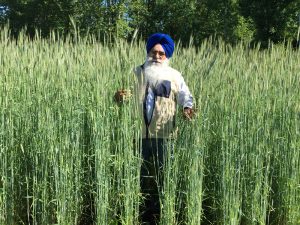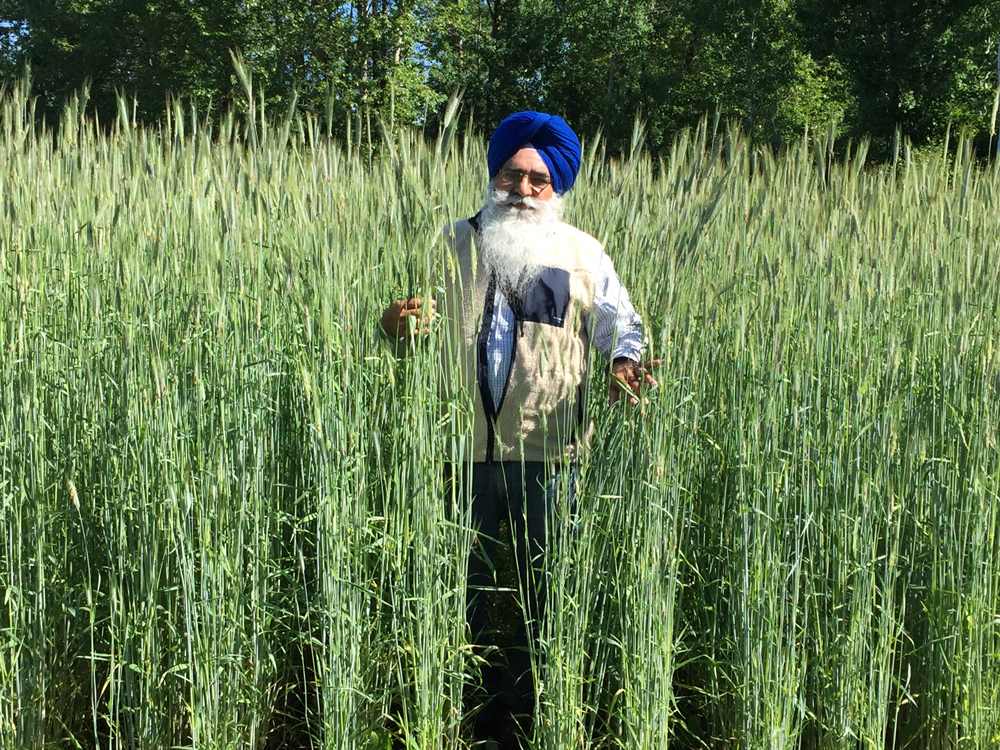 Cultivation of winter cereals have several advantages (www.tbars.net/bumperwinter.pdf). Optimum time of seeding and selection of suitable varieties are the prerequisites to get economic high yields from winter cereals. Optimum window for seeding winter wheat in northwestern Ontario is August 25 to September 7, which could be extended to September 15 with some loss in grain yield. Winter rye, being more winter hardy than winter wheat, could be seeded up to September 20 or even later. Winter rye seeded on October 15 last year at TBARS Thunder Bay survived one of our worst winters/and springs (storm in early May with freezing rain, ice pellets and snow!).
Cultivation of winter cereals have several advantages (www.tbars.net/bumperwinter.pdf). Optimum time of seeding and selection of suitable varieties are the prerequisites to get economic high yields from winter cereals. Optimum window for seeding winter wheat in northwestern Ontario is August 25 to September 7, which could be extended to September 15 with some loss in grain yield. Winter rye, being more winter hardy than winter wheat, could be seeded up to September 20 or even later. Winter rye seeded on October 15 last year at TBARS Thunder Bay survived one of our worst winters/and springs (storm in early May with freezing rain, ice pellets and snow!).
High yielding hard red winter wheat varieties: Averaged over three years (2012-2015), Swainson 7.58 MT grains/ha, Moats 6.76 MT grains/ha, and AAC Gateway 6.57 grains/ha recorded highest yield among the 11 varieties tested. Except last year, AAC Gateway (plant height of 87 cm; shortest of all) had given the highest grain yield and should be preferred if height/lodging is a concern. One of the Slate River Valley producers has grown AAC Gateway in 2016-’17 and it has an impressive growth; something unseen in earlier years of winter wheat cultivation in Thunder Bay! Straw yields in these varieties ranged from 15.5-16.4 MT/ha, with Swainson producing the highest straw yield. Among Ontario winter wheat varieties Gallus gave the highest grain yield of 6.78 MT/ha (straw yield 9.33 MT/ha). Seed suppliers’ contacts (for both winter wheat and rye) may be found in TBARS Annual Report 2016. Brief characteristics of these varieties are as follows:
AAC Gateway: is also eligible for Canada Western Red Winter (CWRW) wheat class. It has a good winter survival, short straw of excellent strength, high grain protein concentration, and resistant to intermediate responses to stem rust, leaf rust, stripe rust and fusarium head blight. Its End-use suitability analysis indicated improvements in protein concentration, amylograph viscosity, dough rheology, loaf volume, and lower protein loss on milling*. AAC Gateway seed may be available locally!
Moats: is eligible for Canada Western Red Winter (CWRW) wheat class. It has excellent stem and leaf rust resistance and it grew up to 103 cm tall at TBARS.
Swainson: is characterized as Canadian Western General Purpose (CWGP) wheat, has stem and leaf rust resistance and grew 109 cm tall at TBARS.
Gallus: is an Ontario winter wheat variety. It has high leaf disease and Fusarium Head Blight tolerance and excellent lodging resistance. In trials at TBARS, it grew 97 cm tall and gave the highest grain yield (6.78 MT/ha) in 2016. Its straw yield was not the highest, though reasonably good (9.33 MT/ha)! It matured in ~11 months; same as other varieties.
High yielding hard red winter rye varieties: Bono, Brasetto, Guttino and Hazlet are the high yielding winter rye varieties that grow taller than 120 cm with grain yields of up to 9 MT/ha and straw yield ranging from 8-9 MT/ha. Bono, Brasetto and Guttino are hybrid winter rye varieties from KWS Germany. Brief traits of these varieties are as follows:
Bono: has given 120-131 % higher grain yield than Hazlet in western Canada. It has uniform maturity, very good lodging resistance, and has desirable qualities (very high falling number and consistent seed size) for the high value food markets (www.fpgenetics.ca/rye_bono.php).
Brasetto: gave 119-124 % higher grain yield than Hazlet in western Canada (though not at TBARS Thunder Bay). Brasetto has higher quality production (high falling number) that is preferred for the milling and distilling market. It is uniform in maturity and has very good lodging resistance (www.fpgenetics.ca/rye_brasetto.php).
Guttino: is licensed to SeedNet. It was 8 cm shorter than and had similar grain yield to Hazlet in our plots at TBARS Thunder Bay. It has excellent grain quality with excellent falling numbers (280-310), and is claimed to be the best of all rye varieties on the market. It has very high silage yield of good quality with early harvest (www.stampseeds.com/guttino-hybrid-fall-rye.html).
Hazlet: has good winter survival. It can germinate at temperatures as low as -1 °C to 2 °C, though vegetative growth requires a temperature of at least 4 °C. Kernels are reported to be about 16 % larger and the test weight significantly greater than the old cultivars. Averaged over three years (2013-‘15), its grain yield at TBARS Thunder Bay was ~800 kg/ha greater than that of Prima and was only 164 kg/ha lower than that from Guttino!
Cultivation Practices: Please visit http://www.tbars.net/Shall_I_seed_winter_rye_this_fall.pdf for cultivation practices of winter rye and http://www.tbars.net/bumperwinter.pdf for cultivation practices of winter wheat.
Any questions? Please feel free to contact me at tarloksahota@tbaytel.net or at 807-473-5707.
*www.pgdc.ca/pdfs/wrt/cultivardescriptions/AAC%20Gateway.pdf

